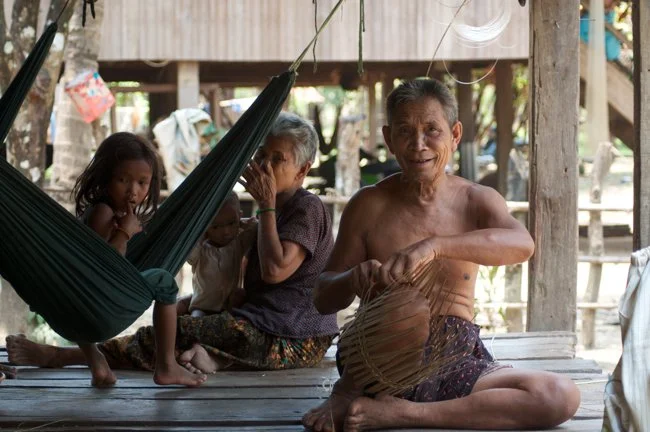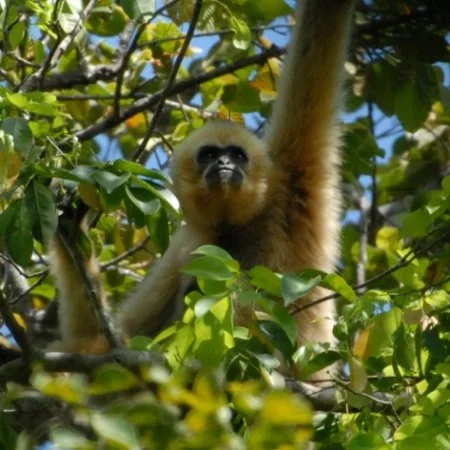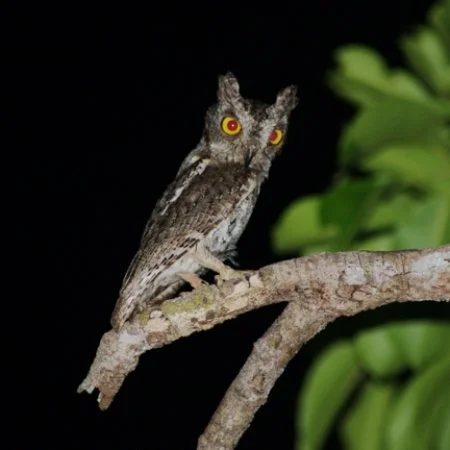Singing with Gibbons
Adventures in the forests of Northeast Cambodia on the trail of a newly discovered species of gibbon and the efforts being taken to protect them.
Travel+Leisure Southeast Asia, October 2012
An adult male gibbon moves effortlessly in the treetops. © Conservation International.
The rich forests of Ratanakiri province in northwest Cambodia are home to a recently discovered species of gibbon. This remote habitat, called the Veun Sai-Siem Pang Conservation Area, is a safe haven in which the population hopefully will thrive. A newly developed conservation initiative aims to protect the forest and this species through funding generated by ecotourism.
There are only 15 gibbon species in the world, so the discovery of a new one three years ago was big news. The northern yellow-cheeked gibbon is found across northeast Cambodia, Laos and Vietnam, but the small population faces growing threats: poaching, illegal logging and agricultural development could destroy the environment that sustains them. Habitat destruction has already decimated gibbon populations in Vietnam, and conservationists hope that the influx of revenue from tourists will help the small population of 500 family groups in northeast Cambodia avoid a similar fate.
I set out on a journey through the jungle in hopes of spotting the amber apes with my own eyes. Only mated gibbon pairs sing and as we stood in the gray pre-dawn on the edge of thick woods, we heard the first eerie notes, like the mournful song of a lost and lonely whale. After a short while, the female chimed in with a rising call, and soon the pair launched into a delirious whooping, whirling duet that could be heard up to three kilometers away. The song, which marks the family group territory, lasts for up to 10 minutes—a brief window of time for the guides to find the singers. So they leapt into the forest and, without hesitation, we plunged in after them.
At home in Ratankakiri. © Nicky Sullivan.
We raced on, barely able to see the person ahead through the dim light and dense foliage, until our guides brought us to a stop. They had found the family casually going about their morning rituals. We watched in breathless fascination as they moved across the canopy, 30 meters up in the treetops, in a languid flow that was embarrassingly at odds with our own stumbling, puffing progress below. In the jungle, it definitely makes more sense to be a gibbon.
The family was entirely unperturbed by our presence—if they took note of our clumsy maneuvers at all, I imagined it would have been to laugh. But they have become used to humans, most often in the form of researchers with pots running around trying to catch their falling droppings, which must seem an odd pastime to the gibbons. The scientists are studying the gibbons’ role in seed dispersal, an essential part of the forest’s regeneration and survival.
Climbing through the foliage. © Conservation International.
We were on the inaugural tour here in a partnership program of Conservation International, two Cambodia-based tour companies and the Kavet, the local hill tribe, who share the territory with the gibbons. The Kavet live in harmony with the apes, which they believe to be ancestral humans, forced into the trees after an ancient flood. Other communities in this area, where international borders mean little, have other ideas however, and the gibbons are hunted for the pet trade, meat and their supposedly medicinal body parts. Ending the poaching of gibbons has been an on-going struggle.
In the last three years, new species of skink and bat have also been discovered in this “biological hotspot,” and protection of the site’s biodiversity is the primary focus of the project.
“The idea of the ecotourism project is to make a link between conservation, using gibbons as the central focus, and livelihood security for the local community,” says Ben Rawson, the regional primate expert for Conservation International The goal is to convince local communities that preserving the environment is more lucrative than destroying it. It is a method that has worked at some other sites across Cambodia, for example at Tmatboey, in Preah Vihear Province, where conservationists were able to protect the wild giant ibis population.
The common scopes owl out on the prowl. © Nicky Sullivan.
On the tour, we spent two heartpounding hours tracking the gibbons, while the air hummed with the music of bugs and birds. Our guides, who seemed to be able to see through trees, pointed out dainty tree frogs; electric blue lizards; owls; squirrels; and dozens of other mysterious creatures that populate the enigmatic jungle. The camp is set in the middle of this wilderness and is fittingly rudimentary. It wouldn’t be an adventure otherwise. And the focus is, of course, not on our creature comforts, but on the comfort of the creatures.
gibbonspottingcambodia.com; US$400 per person for two people; US$300 per person for three to six people. (*prices may have changed)



